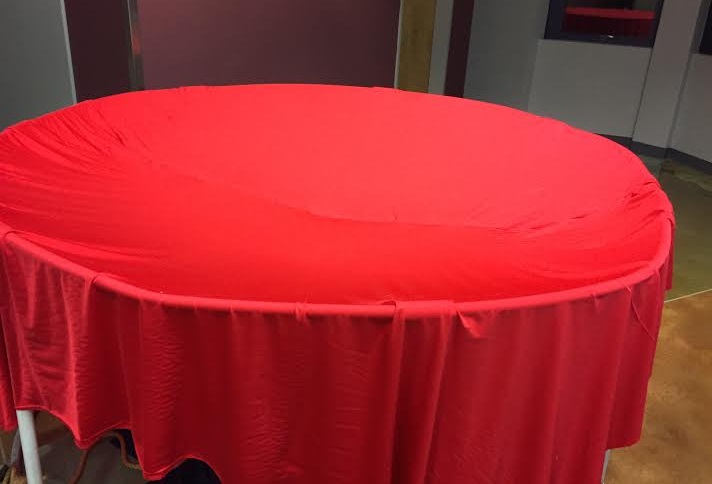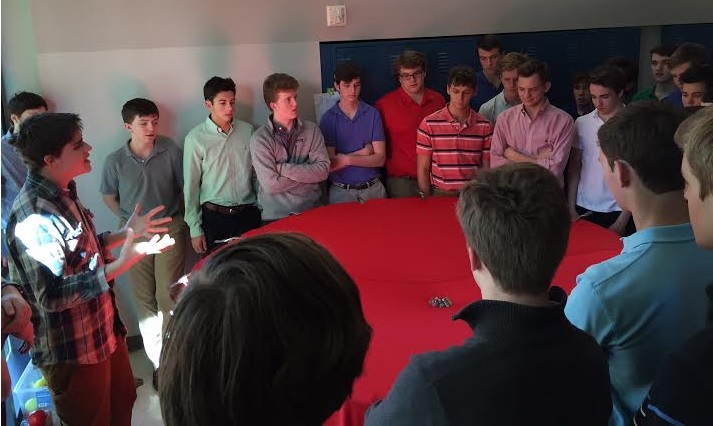Sometimes, we get strange looks buying things in stores. Like the one asking why we’re buying five yards of hot red spandex using a tax-exempt form. Then there are the looks of helpless pity from homeowners just trying to fix their sink as these two people stumble through the hardware store aisles clutching an irresponsible number of 8-foot lengths of electrical conduit, knocking paint brushes from their display hooks. There are the strange looks from students as we spend five hours, attempting to assemble what appeared to passerby as a gigantic hamster wheel, only for it to snap apart over and over, vaulting PVC fittings into the air in the Barry commons.
There’s a simple explanation for the strange looks. We (Tim Nendick and Andrew Wilson), are physics teachers. Physics teachers are generally strange people. During our section on gravity, a student shared a video with Mr. Wilson that represented gravity as dips and ripples along a trampoline-like fabric. The fabric represents a math function that is tedious to calculate by hand and difficult to imagine. That math, though, shows why gravity exists and how different objects change gravity. It’s an important, little, piece of understanding the rules that govern our universe. Mr. Wilson showed the video to Mr. Nendick, who promptly said, “Let’s build that.”

Following the plans that physics teacher Dan Burns devised, we purchased the necessary supplies from our local hardware and fabric stores and began constructing our gravity simulator. We devised the (optimistic) timeline for its completion. We anticipated how much our students would enjoy the live, interactive demonstration. We learned how to use a heat gun, how to thread a sewing machine, and how to fill out a Missouri sales tax exemption form.
We also learned that our conduit wouldn’t bend as nearly easily as the instructions said it would. Students nearby might have learned that physics teachers angrily grumble when this happens.
But we completed it, and on Friday of that week, shared our creation with our students. We placed a heavy weight in the center and released marbles onto the fabric, watching them fall into the sinkhole. When we rolled the marbles to the side, we achieved that effect so similar to a coin spiraling into its funnel hole: centripetal acceleration, we explained, is the same mechanism keeping our solar system’s planets in orbit around the sun.

At the time of the demonstration, the LIGO experiment had just observed gravity waves for the first time (and helped affirm one of Einstein’s theories). If you roll two croquet balls onto the fabric, they start to orbit rapidly as they attract each other. Right before they collide, the fabric shakes up and down a little. This is almost exactly the same thing that happens as two black holes merge, and that fabric shake is effectively a gravity wave. As students were hearing about the discovery on the news, they had a real visible thing to relate it back to (even if that thing was bright red spandex).
Our lesson covered binary stars, conservation of momentum, escape velocity and planet formation. The gravity simulator, though limited in its two-dimensional representation, succeeded in showing the students the gravitational interactions between bodies in three dimensions. It was also a great excuse for us to play around with marbles for an entire class period.
Disassembly of our simulator took a measly ten minutes, and set up of it again next year will take about the same. Our vision of STEAM is fostering that spur-of-the-moment inspiration not only in our students, but in ourselves. Over time, we hope to build and amass more of these homemade demonstrations, modeling for our students the ability to teach themselves, and create for themselves, new things every day.
And if we do that well, then we won’t be the only ones buying strange collections of parts at the hardware store.




Comments